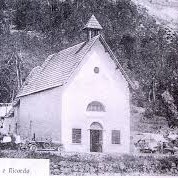They call him “the Dolomites Apostle”. In these mountains, several places have his name and various churches are dedicated to him. He lived in the first half of the V century and, being bishop of Sabiona (now called Chiusa, ten kilometers from Bressanone, where that bishopric was later transferred), during a famine, he allowed his faithful to use dairy products during Lent. Denounced for this to Pope Celestine I (422432), he was invited to Rome to apologize. The miracles that accompanied him during his journey and stay in the city were worth more than any excuse.
When he returned, the enemies (the Aryans?) forced him to leave the headquarters again. He then retired to a hermit life in the Fiemme Valley, where you can visit the small village and the church dedicated to him. But neither there he felt safe, so he crossed the crags and went down towards the Conca Agordina, in the so-called Valle di S. Lugano. He took refuge in a cave, the “Col di S. Lugano”, a place he left only to evangelize and spiritually heal the people of the area.
In one of these missions, in Listolade, he met the blessed Avazia or Vaza, who, having obtained permission from her husband, retired to a hermit life under the spiritual direction of the saint. On the tomb of Lugano, near Taibon, a church was built; destroyed by an avalanche, it was rebuilt in 1635. G. Mezzacasa thinks that Vaza – who lived at least five centuries after St. Lucano – was his contemporary and spiritual daughter because she led an ascetic life in this small church, where she was buried too.
These are the legends around the places that take their name from the Saint. An extraordinary flowering of the cult of St. Lugano occurred in the XIII and XIV centuries. Proof of this, are the three churches built in his honor at that time, as well as the one where he was buried near Taibon, at the Passo di S. Lugano, next to a hospice (1325-1332), in Villapiccola near Auronzo (not after 1352) and Belluno (1396).
In the cathedral of the latter city, they transported the Saint’s body from Taibon (probably in 1307), where only one relic is preserved; there he was buried within an ark adjacent to the main altar. This was opened on the 17th June of 1400 in the presence of the bishop for the recognition of the relics and reopened in 1658 to extract some to donate to Antonio Crosini, bishop of Bressanone.
Every year, in the church of St. Lugano, ended the procession on the Ascension’s eve, after having gathered the faithful from the villages of the Agordino community. This procession was later transferred and is still celebrated on June 20, the anniversary of the Saint’s death or, according to the Bollandisti, of the transfer of his body to Belluno.




